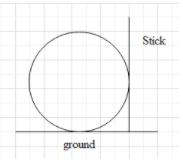
A boy is pushing a ring of mass 2kg and radius 0.5m with a stick as shown in the figure. The stick applies a force of 2N on the ring and rolls it without slipping with an acceleration of $0.3m{{s}^{-2}}$. The coefficient of friction between the stick and the ring is $\dfrac{P}{10}$. The value of P is:

A. 1
B. 2
C. 3
D. 4

Answer
570.3k+ views
Hint: To solve this question first we need to find the force of friction between the ring and the stick and the friction between the ring and the ground. The force from the stick to the ring can be expressed as the normal force to the ring. From the given data, balance the forces and obtain the force of friction and then we can find the value of P.
Complete answer:
Given in the question that,
The mass of the ring is $m=2kg$
The radius of the ring is $r=0.5m$
The stick applies a force of 2N on the ring. This is the normal force on the ring from the stick.
Again, the ring is accelerating with $a=0.3m{{s}^{-2}}$
Let, the frictional force between the ring and the stick is ${{f}_{a}}$
And the frictional force between the ring and the ground is ${{f}_{s}}$
We can write,
$\begin{align}
& N-{{f}_{s}}=ma \\
& 2-{{f}_{s}}=2\times 0.3 \\
& {{f}_{s}}=1.4N \\
\end{align}$
The torque of the ring about the centre can be mathematically expressed as,
$\left( {{f}_{s}}-{{f}_{a}} \right)r=I\alpha $ ---- (1)
Where, I is the moment of inertia of the ring about the centre and $\alpha $is the angular acceleration of the object.
The angular acceleration can be mathematically expressed as,
$\begin{align}
& a=\alpha r \\
& \alpha =\dfrac{a}{r} \\
\end{align}$
Again, the moment of inertia of the ring can be expressed as,
$I=m{{r}^{2}}$
Putting the above values on the equation 1 we get that,
$\begin{align}
& \left( 1.4-{{f}_{a}} \right)\times 0.5=m{{r}^{2}}\times \dfrac{a}{r}=mra \\
& \left( 1.4-{{f}_{a}} \right)\times 0.5=2\times 0.5\times 0.3 \\
& 1.4-{{f}_{a}}=0.6 \\
& {{f}_{a}}=0.8N \\
\end{align}$
The force of friction between the ring and the ring can be expressed as,
$\begin{align}
& {{f}_{a}}=\mu N \\
& 0.8=2\mu \\
& \mu =0.4 \\
\end{align}$
Now, the coefficient of friction between the ring and the stick is $\dfrac{P}{10}$
$\begin{align}
& \mu =\dfrac{P}{10}=0.4 \\
& P=4 \\
\end{align}$
The correct option is (D).
Note:
The ring is moving around the axis passing through the centre perpendicular to the plane of the ring. So, the moment of inertia of the ring is measured around the axis passing through the centre. Again, the ring is moving in the ground and the force on the ring is due to the force by the stick. So, we need to consider the frictional forces from both the ground and the stick.
Complete answer:
Given in the question that,
The mass of the ring is $m=2kg$
The radius of the ring is $r=0.5m$
The stick applies a force of 2N on the ring. This is the normal force on the ring from the stick.
Again, the ring is accelerating with $a=0.3m{{s}^{-2}}$
Let, the frictional force between the ring and the stick is ${{f}_{a}}$
And the frictional force between the ring and the ground is ${{f}_{s}}$
We can write,
$\begin{align}
& N-{{f}_{s}}=ma \\
& 2-{{f}_{s}}=2\times 0.3 \\
& {{f}_{s}}=1.4N \\
\end{align}$
The torque of the ring about the centre can be mathematically expressed as,
$\left( {{f}_{s}}-{{f}_{a}} \right)r=I\alpha $ ---- (1)
Where, I is the moment of inertia of the ring about the centre and $\alpha $is the angular acceleration of the object.
The angular acceleration can be mathematically expressed as,
$\begin{align}
& a=\alpha r \\
& \alpha =\dfrac{a}{r} \\
\end{align}$
Again, the moment of inertia of the ring can be expressed as,
$I=m{{r}^{2}}$
Putting the above values on the equation 1 we get that,
$\begin{align}
& \left( 1.4-{{f}_{a}} \right)\times 0.5=m{{r}^{2}}\times \dfrac{a}{r}=mra \\
& \left( 1.4-{{f}_{a}} \right)\times 0.5=2\times 0.5\times 0.3 \\
& 1.4-{{f}_{a}}=0.6 \\
& {{f}_{a}}=0.8N \\
\end{align}$
The force of friction between the ring and the ring can be expressed as,
$\begin{align}
& {{f}_{a}}=\mu N \\
& 0.8=2\mu \\
& \mu =0.4 \\
\end{align}$
Now, the coefficient of friction between the ring and the stick is $\dfrac{P}{10}$
$\begin{align}
& \mu =\dfrac{P}{10}=0.4 \\
& P=4 \\
\end{align}$
The correct option is (D).
Note:
The ring is moving around the axis passing through the centre perpendicular to the plane of the ring. So, the moment of inertia of the ring is measured around the axis passing through the centre. Again, the ring is moving in the ground and the force on the ring is due to the force by the stick. So, we need to consider the frictional forces from both the ground and the stick.
Recently Updated Pages
Master Class 11 Economics: Engaging Questions & Answers for Success

Master Class 11 English: Engaging Questions & Answers for Success

Master Class 11 Social Science: Engaging Questions & Answers for Success

Master Class 11 Biology: Engaging Questions & Answers for Success

Class 11 Question and Answer - Your Ultimate Solutions Guide

Master Class 11 Business Studies: Engaging Questions & Answers for Success

Trending doubts
10 examples of friction in our daily life

One Metric ton is equal to kg A 10000 B 1000 C 100 class 11 physics CBSE

Difference Between Prokaryotic Cells and Eukaryotic Cells

1 Quintal is equal to a 110 kg b 10 kg c 100kg d 1000 class 11 physics CBSE

Explain zero factorial class 11 maths CBSE

What is a periderm How does periderm formation take class 11 biology CBSE




